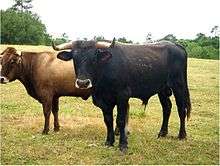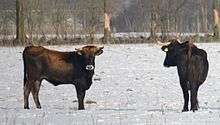Tauros Programme
The Tauros Programme, formerly known as TaurOs Project, is a cooperation between the Dutch foundation Stichting Taurus and universities such as the Wageningen University and Research Centre. It is an international effort to breed a type of cattle that resembles the extinct aurochs, the wild ancestor of domestic cattle, to a large extent.

The project largely uses hardy cattle breeds with superficial resemblance to the extinct aurochs. By crossbreeding and selective breeding it tries to establish similarity to the aurochs. The long-term goal is to release these Tauros cattle into rewilding areas.
Background
Herbivorous megafauna are considered important tools of nature conservation in maintaining the biodiversity of open or park-like landscapes without human interference. Therefore, it is planned to reintroduce large game in several reserves to recreate the natural dynamics of the European ecosystems. The aurochs was one of the most important European ungulates but was hunted to extinction over most of Europe in the Middle Ages. Despite attempts at conservation, the last known pure-bred aurochs died in Jaktorów Forest, Poland in 1627.[1] Thus, so-called rewilding has to work with its domesticated descendants, of which several breeds are hardy and robust enough to fill this gap. In many grazing projects, especially in Germany, Heck cattle are used, together with Galloways and Highland cattle. Heck cattle originated in the 1920s as an attempt by Lutz and Heinz Heck to breed an aurochs look-alike from several cattle breeds. Heck cattle turned out to be a hardy breed, but are found to be considerably different from the aurochs in several aspects.[2]
TaurOs Project formed to achieve a breed of cattle which is closer to the aurochs than previous breeding back attempts. This is based on the idea that original features of the aurochs are still present in some less-derived cattle breeds and can be reunited by crossbreeding and selective breeding to the largest possible degree. Stichting Taurus has been running grazing projects with hardy cattle and horses for years and bought numerous cattle breeds found to be authentic for the project from southern Europe.[3] [4]
Methods and goal

TaurOs Project uses very hardy cattle breeds, which should preferably resemble the aurochs to a useful extent. Crossbreeding and selective breeding with such breeds should create new lineages which are hoped to come close to the aurochs as much as possible and are fit for being released in European wild reserves. Not only the phenotype and robustness are in the focus of breeding, but also genetic information of the aurochs which might be preserved in these breeds is considered. There are variations within each breed, so selection criteria are necessary to select the individuals to be included on the project. Accordingly, studies are running parallel under the umbrella of the project, e.g., to evaluate possible introgression of wild aurochs into the European cattle population. Furthermore, the food choice and behaviour of the used breeds are examined.[5]
The breeds which are used for crossbreeding mostly stem from the Iberian Peninsula and Italy. For example, these are Sayaguesa Cattle, Pajuna Cattle, Italian Podolica and Maremmana primitivo. Although claimed to be genetically close to the aurochs, the Lidia breed (Spanish fighting bull) was not used for the project due to its aggressive behaviour.[6] These primitive breeds have decreased in numbers during the last decades, and some are highly endangered. Scottish highland cattle are used as well, because this breed has a long and dense coat and is very hardy. Several cross individuals have been born already.[7]
Members of the project hope that the Tauros cattle will one day be able to move freely in wild herds in European nature areas just as red deer, wild boar, and wolves do.[8][9]
Meanwhile, the genetic relationship between a number of cattle breeds and the aurochs is examined.[6]
Breeds in use and present crossbreeding results

Following robust cattle breeds are presently used:
- Sayaguesa Cattle
- Maremmana primitiva
- Pajuna Cattle
- Limia Cattle
- Maronesa
- Podolica
- Highland Cattle
- Tudanca Cattle
- Boškarin
All breeds except Boškarin are being used for breeding in the Dutch herds. Outside of the Netherlands, mainly Sayaguesa, Maremmana, Maronesa and Boškarin are being used as founding breeds, supplemented by crossbreeds from the Dutch sites.[10] By the end of 2015, over 150 animals of the founding breeds have been used in breeding, and almost 300 cross animals have been born, among them 17 animals already of the fourth cross-generation.[10]
- Maronesa cow in Keent
- Young Sayaguesa bull
- Maremmana x Highland (cow)
- Sayaguesa cross cow
- Podolica cow
- Sayaguesa cow
Locations
- Netherlands: In Nature reserve Keent (Oss), Kempen~Broek (Weert), Herperduin-Maashorst (Oss/Uden), Kraaijenbergse Plassen (Cuijk), De Maurik (Mill), and Geuzenbos (Rotterdam Harbour).[11][12]
- Portugal: Since 2013 in Faia Brava.[12][13]
- Spain: Since 2013 in Campanarios de Azaba.[12][13]
- Croatia: Since 2014 in the Lika plains at the foot of the Velebit Mountains.[12][14]
- Czech Republic: Since 2015 in Milovice Nature Reserve[15] and since 2018 in Modrá (Uherské Hradiště District).
- Romania: Since 2015 in Sfântu Gheorghe (Danube Delta).[12][16]
See also
References
- Rokosz, Mieczyslaw (1995). "History of the Aurochs (Bos Taurus Primigenius) in Poland" (PDF). Animal Genetics Resources Information. Food and Agriculture Organization. 16: 5–12. doi:10.1017/s1014233900004582.
- Cis Van Vuure (2005). Retracing the Aurochs: History, Morphology & Ecology of an Extinct Wild Ox. Pensoft Pub. ISBN 954-642-235-5.
- "Project TaurOs || Stichting Taurus". Stichtingtaurus.nl. Archived from the original on 3 December 2013. Retrieved 10 March 2012. [dead link]
- http://www.taurosproject.com/
- "The Aurochs is coming back to European forests and grasslands | European WILDLIFE". Eurowildlife.org. Retrieved 10 March 2012.
- Ronald Goderie. "2012 – when the Tauros started growing wings". rewildingeurope.com. Retrieved 14 March 2013.
- "Nieuws || Stichting Taurus". Stichtingtaurus.nl. Retrieved 10 March 2012. [dead link]
- "Website ark - Oerrund keert terug" (in Dutch). Ark.eu. 2011-11-22. Retrieved 10 March 2012.
- "Uitgestorven oerrund komt terug naar Limburg" (in Dutch). Gva.be. Retrieved 10 March 2012.
- Rewilding Europe: “Tauros Programme.” Continually updated webpage w/o date. Retrieved 23 February 2017.
- Stichting Taurus: “Terreinen.” Retrieved 1 September 2016. (in Dutch)
- The Tauros Programme: “Locations. Where to meet the Tauros.” Retrieved 1 September 2016.
- Rewilding Europe: “Western Iberia. Achievements to date.” Retrieved 1 September 2016.
- Rewilding Europe: “Velebit. Achievements to date.” Retrieved 1 September 2016.
- Česká krajina: “První stádo praturů ve střední a východní Evropě se zabydluje v Milovicích.” 13 October 2015. Retrieved 1 September 2016. (in Croatian)
- Rewilding Europe: “Danube Delta. Achievements to date.” Retrieved 1 September 2016.
External links
| Wikimedia Commons has media related to Tauros Programme. |